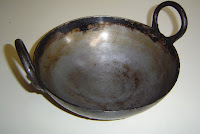Obstacles on the path to the chutney kingdom


Alton Brown in his fine book "Alton Brown's Gear For Your Kitchen", loaded with information garnered over the years with the school-of-hard-knocks-approach, says, "When deciding whether to break out the food processor or the blender, here's a good rule of thumb: use a food processor for pureeing food that is more solid than liquid and a blender for food that is more liquid than solid." Though chutney falls into the former category, the food processor does not work for the chutney, according to me. I tried to make the tomato chutney and the opu squash chutney in a food processor. They turned out to be a sad imitation of a mush. Big chunks of chile skin - sure to get stuck in teeth - were left behind, the tomatoes already wilted by cooking broke down further (which could have been accomplished by cooking too) and I could still see distinct bits of peanut powder. The opu squash chutney became granular. What the food processor did was reduce each and every ingredient to granular bits without any major interaction between the ingredients. It failed to process the chutney as an organic whole. All the components remained conspicuously apart and the end product was less than the sum of the ingredients - in texture, flavor as well as appearance.
What do you use for chutneys that demand a fine paste like cilantro chutney or a mint chutney? So I was looking for a machine, more of a grinder than a food processor, something that can blow the food to unrecognizable smithereens, if desired। Magic Bullet comes close to that। I do have to add some liquid - either water or lime juice - to make the Magic Bullet reach its full potential but it does reduce say a cilantro or a mint chutney to an admirable texture।
Let me give you the recipe of my favorite chutney, the tomato chutney and you can decide for yourself if the trouble is worth it।
Classic Tomato chutney
With what
- 3 plum tomatoes
- 6 long green chiles
- 2 tbsp peanut powder
- 1 tbsp oil
If you are using Jalapeño or Serrano pepper, use just two. Serrano is way hotter and Jalapeños tend to be rather unpredictable.
How to make
Wash the tomatoes and chop them into 3/4 inch pieces. In a pan add oil to the tomatoes and the peppers. Turn the heat on medium. There are two ways to get this mixture cooked. Either keep an eye on it and sauté frequently or cover the pan with a lid. With the lid what will happen is the tomatoes will sweat and become runny after about ten minutes. Let the liquid left off by the tomatoes evaporate. Before you turn the heat off, check for the color of the peppers. They should have turned a pale green from their earlier bright green. In short make sure that the peppers are cooked too. Otherwise the chutney will turn out way too hot. Once this mushy tomato/chile mixture has cooled, put it in a blender. Add peanut powder, cumin and salt. Blend it, though, not too fine. Add fodni.
Fodni - Heat oil in a small, preferably narrow and round saucepan. Add mustard seeds. If the oil has heated up well, as soon as you add the mustard seeds they start popping. Let them finish popping. You might want to cover the saucepan to avoid the seeds hitting your skin (it feels like you got a tiny pinch with nails, that stings more than when a large portion of the skin is squeezed) and flying all over the place. Once that is done, add asafetida and turmeric. Turn the heat off and add the fodni to the tomato chutney. Once you hear the 'cchrrr' sound of the fodni hitting the chutney, it is ready to be devoured. Fodni not only makes the chutney creamier but also changes its appearance. From a pale, muddy-red mush it suddenly comes to life. Now it has a bright yellow hue with specks of black seeds.
How to eat
Eat as a dip with tortilla chips or warm pita bread. Also works as a great sandwich spread if sour cream or cream cheese is added.
Stay tuned for the next post. It's on peppers, chiles or whatever you call them.


Comments